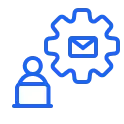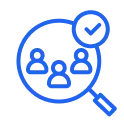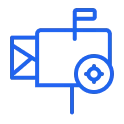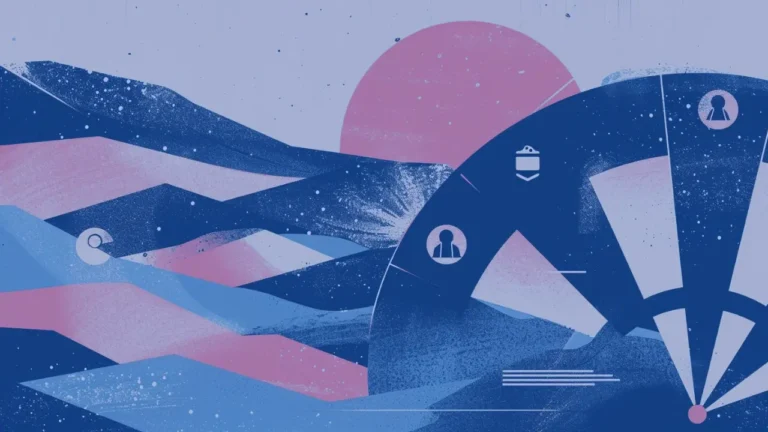When it comes to building a robust sales team, Sales Development Representatives (SDRs) are the cornerstone that set the foundation for success.
Their role in identifying and nurturing potential leads can significantly impact the company’s sales pipeline.
Consequently, hiring a SDR is not just a task—it’s a strategic operation that requires careful planning and execution.
TL;DR
- SDRs are key to lead generation and nurturing, crucial for sales pipeline success.
- Hiring SDRs strategically impacts long-term growth and requires careful candidate evaluation.
- SDR hiring must align with a company’s culture; essential skills include communication and adaptability.
- Practical candidate assessments and effective interviewing techniques are critical in the SDR hiring process.
- Effective SDR onboarding and clear career paths are vital for retention and integrating new hires.
- Outbound sales tools like Growbots can be an alternative to SDR teams, enhancing scalability and efficiency.
- A targeted SDR recruitment strategy is essential for assembling a high-performing sales team.
- Exploring Growbots’ free trial offers a risk-free opportunity to experience how automated sales features can streamline your prospecting and outreach efforts.
leave no lead unexplored
Every potential client within reach
- 180m+ contacts
- CRM integrations
- 23 Prospect filters
- 15 Company filters
Introduction to Hiring SDRs
Reflect upon the recruitment process; it is the first point of contact between your organization and future sales talents. This early stage can shape not only immediate recruitment results but also long-term sales outcomes and team dynamics.
Here’s why a systematic approach to hiring SDRs is crucial for any business aiming to boost its sales force:
| Strategic Importance | Description |
| Lead Generation | Sourcing new potential clients through various channels. |
| Qualification | Assessing leads to ensure they meet the criteria for potential customers. |
| Efficiency | Alleviating the workload of closing staff, thus optimizing the sales team’s focus. |
| Revenue Impact | Directly influencing the quality and quantity of the sales pipeline. |
| First Impressions | Good SDRs create positive initial engagement with potential clients. |
| Long-term Impact | Properly recruited SDRs contribute to sustained growth. |
Statistics from industry studies and case studies from high-performing sales teams provide evidence of the SDR’s value in attaining sales targets and sustaining business development.
Their specialized skills in prospecting and nurturing leads have made them an integral part of successful sales strategies. Read more about how to build an efficient SDR team.
Identifying the Need for an SDR in Your Business
Recognizing the right time to bring an SDR on board can be a turning point for your business.
Certain signs and triggers suggest that your company might benefit from the specialized skills of an SDR.
These include a rise in untapped market opportunities, an overburdened sales team, or a strategic shift towards proactive outreach. The decision should be based on both current needs and future growth projections.
Consider the following scenarios to evaluate the alignment of an SDR with your business’s growth stages:
- Expansion into new markets: Requires dedicated prospecting to build relationships.
- Increasing product or service complexity: Necessitates skilled explanation and education during the early stages of customer engagement.
- Enhanced focus on outbound sales strategies: Leverages the SDR’s expertise in generating quality leads through targeted efforts.
Now, let’s delve into the specifications of the SDR role to ensure clarity in your recruitment initiative.
Defining the SDR Role
Understanding the specifics of the SDR position is key to sourcing the right candidates.
SDRs are typically responsible for the early stages of the sales process, including prospecting and qualifying leads. Their primary objectives involve outreach to potential clients and setting up appointments for the sales team.

It is essential to recognize the SDR role as more than just a stepping stone in the sales career ladder; it’s a specialized function that can have a profound effect on the conversion rates and overall efficiency of your sales operation. Below is a snapshot of what to expect from an SDR:
| Key Responsibilities | Desired Skills and Traits |
| Generating and qualifying leads | Excellent communication skills |
| Scheduling appointments and demos | Persistence and resilience |
| Nurturing leads through follow-ups | Adaptability to sales technologies |
With a firm grasp of the role, we can now move on to envisioning your ideal SDR candidate:
Visualizing Your Ideal Candidate
Cultivating a clear picture of the ideal SDR for your company is about aligning the candidate’s attributes with your organizational needs and culture. Identifying the right fit goes beyond skills and experience; it encompasses motivation, cultural fit, and the potential for growth within your company. When visualizing your ideal SDR candidate, consider the following characteristics table:
| Characteristics | Description |
| Cultural Fit | Aligns with company values and work environment. |
| Motivation | Driven to exceed targets and grow professionally. |
| Technical Proficiency | Adept with sales tools and software. |
| Sales Aptitude | A natural ability to engage and persuade. |
By establishing this profile, you’re not just hiring for the current role, but also considering the candidate’s potential evolution within the company.
Qualifications and Skills Required for SDRs
When hiring an SDR, certain qualifications and skills are paramount to ensure that they will perform successfully in their role.
While some skills can be developed on the job, others are essential from the outset.
Here is a table that contrasts desirable versus essential skills for an SDR:
| Desirable Skills | Essential Skills |
| Advanced CRM knowledge | Proficient in Salesforce or a similar CRM |
| Prior sales experience | Strong communication skills |
| Industry-specific knowledge | Ability to quickly learn and adapt |
| Data analysis capabilities | Resilience and persistence |
SDRs must be adept communicators, capable of engaging prospects and enticing interest in the company’s offerings.
They should also possess a fundamental understanding of the sales process and the ability to learn and adapt quickly, as they will often be tasked with relaying complex information in a simple, persuasive manner. Discover the role of creativity in sales strategies.
Educational Background of SDR Candidates
The educational background of SDR candidates can vary widely, reflecting the diverse skill sets that the role requires. Typically, employers look for a bachelor’s degree in business, marketing, communications, or a related field. However, the priority is often placed on experience and skill set rather than formal education. Candidates with a strong track record in customer service or sales, even without a higher degree, are frequently considered for SDR positions.
Here’s a comparative list outlining how formal education might influence the hiring process for SDRs:
- Formal Education: Provides a theoretical foundation and understanding of business principles.
- Sales Experience: Often more indicative of a candidate’s potential success in an SDR role.
- Soft Skills: Crucial in outreach and engagement, which might not be honed through traditional education.
The SDR Hiring Process
Navigating the SDR hiring process requires a methodical approach to ensure you select the right candidate while also providing a positive candidate experience. From the initial job posting to the final decision, each step should be carefully planned and transparent.
In the context of SDR hiring, the report from The Bridge Group in 2023 indicates significant changes in the sales development landscape, including adjustments in average experience, ramp, tenure, and the impact of layoffs on the power dynamic in the hiring market.
Source: salesroads.com
Below is a simplified overview of the hiring process:
| Step | Description |
| Job Posting | Craft detailed listings to attract qualified candidates. |
| Application Review | Swiftly and effectively screen for the best fits. |
| Interviews | Conduct insightful interviews to assess candidates on various competencies. |
| Final Assessment | Use practical tests or assignments to evaluate skills in a real-world context. |
| Offer Extension | Present a compelling offer to the chosen candidate. |
Throughout this process, it is important to communicate openly and provide feedback that can help both your team and the candidates.
Creating an Attractive Job Description
The job description is often the first interaction that potential SDR candidates have with your company. Crafting a compelling job description is about striking a balance between providing a realistic overview of the role and enticing top talent.
Key elements to an effective job description:
- Concise and precise role summary.
- Outline of roles and responsibilities.
- Details about the company culture and aspirations.
- Description of the learning and development opportunities.
A clear and attractive job description sets the stage for attracting high-caliber candidates who are in sync with your company’s objectives.
Making the Role Appealing to Candidates
In a competitive job market, selling the SDR role to candidates is just as important as their qualification for the position.
There’s an increasing emphasis on mental health in the workplace, with employers recognizing its impact on productivity, engagement, and job satisfaction. This focus enhances the overall quality of life for employees and contributes to higher retention rates.
Source: roberthalf.com
It’s crucial to highlight not just the job but the career trajectory and growth they can achieve at your company. Promote the following aspects to attract high-caliber SDR talent:
| Aspect | Detail |
| Company Culture | Emphasize a collaborative and inclusive work environment. |
| Development Opportunities | Offer clear pathways for advancement and skill enhancement. |
| Compensation and Benefits | Have a competitive package that rewards performance and commitment. |
| Company tech stack | Highlight access to leading sales tools and resources. |
Ensure that the potential for professional growth is communicated clearly, reinforcing why your company is a desirable place to work.
SDR Search Strategies
Effective SDR search strategies involve more than just posting job advertisements. Employing a variety of tactics can help you uncover the best SDR talent. These strategies should include proactive sourcing, engaging with sales communities, and leveraging employee referrals.
Consider these search methods for a diverse candidate pool:
- Direct headhunting through professional networks.
- Participation in job fairs and sales-specific events.
- Utilizing advanced sales tools for candidate sourcing.
Leveraging Job Boards and Platforms
The digital era has transformed the recruitment process, with a myriad of job boards and platforms offering access to a vast pool of candidates. The art lies in choosing the platforms that cater to quality SDR talent. Here are some tips for leveraging job boards efficiently:
- Opt for niche job boards tailored to sales professionals.
- Utilize LinkedIn to reach a broader network of passive and active candidates.
- Explore platforms like Glassdoor and Indeed for reviews and employer branding.
In addition to these strategies, remember to refine your search and posting practices. Craft compelling job descriptions that resonate with top sales talent and ensure your company stands out as an employer of choice.
Reach More with Less Effort
Connect with Potential Clients at scale
- AI message generator
- E-mail verification
- Multichannel sequences
- A/B testing
Networking for SDR Recruitment
Networking is an indispensable recruitment strategy, especially for roles as dynamic as SDRs. Tapping into professional networks such as LinkedIn or attending industry events can open doors to connections that may not be actively seeking jobs but are the right fit for your organization.
Consider these networking guidelines:
- Connect with industry influencers and thought leaders who can introduce you to potential candidates.
- Engage with sales communities and forums online to build relationships and brand presence.
- Consider reaching out to sales training programs for access to fresh talent poised to enter the industry.
Furthermore, integrate a call to action in your networking efforts, inviting potential SDRs to learn more about your organization through engaging and informative content like articles on sales strategies and tools.
Resume Screening
Early stages in the hiring process such as resume screening and initial interviews are crucial for filtering the applicant pool. They offer an insight into which candidates should advance to more in-depth interviews.
Steps to effective initial candidate evaluation:
- Prioritize resumes based on matches to the job specification.
- Conduct preliminary interviews to ascertain communication skills and professional demeanor.
- Utilize initial interviews to provide a positive candidate experience.
Efficient screening and interviewing at this stage can save considerable time and result in a more focused selection of candidates for subsequent rounds.
Let’s look into the SDR interview process more thoroughly:
Interview Process for SDR Candidates
The interview process for SDR candidates must be well-structured to ascertain the necessary skill sets and cultural alignment. A successful interview should cover a broad range of topics, from the candidate’s motivation and past experiences to situational sales scenarios.
| Interview Stage | Objective |
| Phone Screen | Assess communication skills and initial fit. |
| In-person / Video Interview | Explore past experiences and assess cultural fit. |
| Role-play exercise | Evaluate sales acumen and problem-solving abilities. |
| Team Introduction | Determine compatibility with potential team members. |
Common interview questions for SDR candidates may include their approach to handling rejection or their methods for staying motivated amidst challenging sales targets.
| Type of interview question | Purpose |
| Behavioral Questions | To assess adaptability, conflict resolution, and teamwork. |
| Situational Questions | To understand decision-making processes and problem-solving abilities. |
| Technical Questions | To gauge proficiency with sales tools and methodologies. |
The right questions will reveal not only the candidate’s abilities but also their potential for growth and adaptability within your sales team.
Mastering the art of cold emailing is a vital skill for any SDR. Read more here.
Incorporating Assessments in the Hiring Process
Including practical assessments in the hiring workflow can illuminate a candidate’s skills and suitability for the SDR role in ways that interviews alone cannot. Various assessment types, such as role-playing or sales scenarios, can gauge the candidate’s practical knowledge and response to real-life sales challenges.
Benefits of using assessments:
| Assessment Type | Benefit |
| Personality Tests | Gauge cultural fit and potential for team collaboration. |
| Skill-Based Scenarios | Assess a candidate’s hands-on skills and problem-solving. |
| Cognitive Ability Tests | Measure a candidate’s ability to learn and adapt. |
These evaluations reveal strengths and weaknesses that are critical for the role of SDR, providing an empirical basis for your hiring decision.
Effective Interviewing Techniques
Refining interviewing techniques can significantly enhance the ability to discern the best SDRs for the team.
A solid approach includes not only asking the right questions but also attentively listening to the responses and observing the nuances in the candidates’ behavior and responses.
Adopting a combination of structured and unstructured interviews, along with a peer panel can yield a more holistic view of the candidate.
| Technique | Benefit |
| Structured Interviews | Ensures consistent assessment across candidates. |
| Unstructured Conversations | Helps gauge personality traits and cultural fit. |
| Peer Panel | Allows the team to meet candidates and provide feedback on team compatibility. |
Incorporating a peer panel into the interview process offers the unique advantage of involving those who will work directly with the SDR.
It gives both the candidate and the current team members the opportunity to interact, helping to assess how the potential new hire may fit into the team dynamic.
The goal is to elicit honest insights into the candidate’s abilities and potential fit with the team.
Remote Hiring and Interview Techniques
The rise of remote work has necessitated adaptations in the hiring process. Virtual interviews and online assessments have become the norm. Developing remote hiring and interview techniques that mirror the effectiveness of in-person interactions is essential for identifying the best talent in a remote or distributed workforce.
Strategies for successful remote interviewing:
- Provide clear instructions and expectations for remote interviews.
- Use video conferencing tools to facilitate a more personal connection.
- Incorporate virtual tour sessions to introduce candidates to team members and company culture.
Remote hiring practices can broaden your talent pool and offer access to a wider range of candidates.
SDR Compensation Structures
The compensation model for SDRs has a significant impact on motivation and performance. A well-thought-out structure should incentivize the behaviors that align with the company’s goals.
48% of SDRs have considered starting a new career in the past six months, with compensation being a key factor. Those satisfied with their compensation are less likely to seek new employment compared to those dissatisfied.
Source: salesroads.com
Here’s an overview of common compensation components for SDRs:
| Compensation Component | Purpose |
| Base Salary | Provides financial stability and reduces pressure. |
| Commission | Rewards meeting or exceeding sales targets. |
| Bonuses | Incentivizes specific achievements or milestones. |
Some companies may also offer non-monetary perks, such as opportunities for advancement, additional training, or flexible working conditions, to attract and retain top talent.
Onboarding and Training New SDR Hires
Onboarding and training are critical to swiftly integrate new SDRs into your sales team. Effective onboarding should ensure that new hires are familiar with company processes, product offerings, and the sales approach. Essential training topics and resources to support SDRs in their new roles include:
- Company culture and values
- Product knowledge and use case scenarios
- CRM and sales tools training
- Sales communication and prospecting techniques
Regular check-ins and feedback sessions are also vital to help new SDRs adjust and improve as they gain real-world experience. Understanding the benefits of sales automation can streamline the SDR role.
no prior experience & time required
Find your winning outbound formula with Concierge
- 95% activities on our behalf
- Avoid in-house SDR hire
- Learn & Take over anytime
- Numerous A/B tests
Challenges in SDR Recruitment and Retention
Recruitment and retention pose challenges that can affect the stability and productivity of a sales team. To address these challenges, employers must adopt a proactive stance involving supportive management, clear communication about career opportunities, and a healthy work-life balance. You can read more about the kind of challenges that SDRs face in another article of ours:
Developing a Career Path for SDRs
A well-defined career path is crucial in retaining talent and ensuring that SDRs see a future within your company. Demonstrate that hiring for the SDR role is not the end, but rather the beginning of a professional journey with your organization. Detail the advancement opportunities, ongoing training programs, and mentorship available.
| Career Development Milestones | Description |
| Initial Training and Onboarding | Set the stage for continuous learning and development. |
| Performance Reviews | Regularly assess progress and re-align goals. |
| Promotion Pathways | Outline potential growth within the sales department. |
Show that your company invests in its employees, leading to higher motivation levels and better performance.
Post-hire SDR Integration Strategies
After the successful hiring of a Sales Development Representative (SDR), it is crucial to focus on the steps required for their effective assimilation into the team and preparing them for success in their new role.
Comprehensive Onboarding
A thorough onboarding process is the first step in integrating a new SDR. This provides them with essential knowledge about the company’s policies, an understanding of the sales process, and introduces them to the products or services they’ll be representing.
Training and Development
Robust training programs are paramount in developing the SDR’s skills. These programs help SDRs enhance their sales techniques, deepen their product knowledge, and gain proficiency in various CRM and sales engagement tools.
Performance Monitoring
Establishing clear performance metrics and regular review processes are essential for tracking an SDR’s progress. Frequent assessment through constructive feedback will help guide their professional development.
Mentorship
Assigning a mentor or an experienced team member to the new SDR can greatly facilitate their learning process. Mentorship offers on-the-job training that is invaluable for fostering the SDR’s career growth.
Team Integration
Encouraging the participation of the new SDR in team meetings and activities can significantly aid in building relationships with their colleagues, contributing to a cohesive team environment.
By maintaining open lines of communication and ensuring that new SDRs are well-supported with the necessary resources, they can quickly become productive members of the sales team, positively impacting the organization’s sales efforts.
Outbound Sales Tools as an Alternative to SDR Teams
Businesses can greatly benefit from utilizing outbound sales tools like Growbots. These tools can complement or even serve as an alternative to building a large SDR team, providing a scalable solution to achieve sales objectives.
Growbots offers a suite of features designed to automate the prospecting and outreach process, which can significantly reduce the manual effort required in these areas. By leveraging such a platform, companies can focus on cultivating fewer, but more skilled SDRs while relying on the technology to handle the repetitive tasks associated with prospecting and lead generation.
Impact of Growbots on Sales Strategy
Here’s how Growbots can impact your sales strategy:
- Automated Lead Generation: Rapidly build targeted lists of prospects based on a variety of criteria.
- Personalized Outreach: Send customized messages at scale, ensuring each prospect feels unique and considered.
- Efficiency and Scalability: Manage multiple campaigns and follow-ups, significantly increasing your outreach capability without a proportional increase in team size.
Incorporating a tool like Growbots can lead to a higher return on investment, allowing sales teams to devote more time to nurturing relationships and closing deals, ultimately driving growth and success. Learn more about Growbots’ capabilities.
Hiring SDRs vs. Using Outbound Sales Platforms: Comparative Analysis
When considering whether to invest in hiring an SDR team or choosing an outbound sales platform like Growbots, it’s important to weigh the pros and cons of each option.
Comparative Table
| Factor | Hiring SDRs | Outbound Sales Platform (e.g., Growbots) |
| Cost | Hiring involves salaries, benefits, and training costs. | Outbound platforms often come with subscription-based models, potentially lowering upfront costs. |
| Scalability | Scaling a team requires additional hiring and management. | Platforms can scale quickly with business needs without additional hiring. |
| Training and Onboarding | New SDRs require training and time to become efficient. | Platforms are designed for ease of use with minimal training needed. |
| Campaign Management | Managing campaigns is dependent on the team’s capacity and skills. | Many platforms offer automation features that streamline campaign management. |
| Flexibility | Adjusting strategies may require retraining or hiring new staff. | Platforms allow for rapid adjustments to strategies with quick implementations. |
| Personal Touch | SDRs can provide a personalized approach to each prospect. | Although automated, many platforms offer personalization options in outreach efforts. |
| Data Analysis and Reporting | SDRs need to manually track and report on their activities and outcomes. | Comprehensive analytics and reporting can be automated and accessed in real time. |
| Innovation and Tech | Staying current with tech trends requires ongoing training and investment. | Outbound platforms typically ensure they incorporate the latest sales and marketing automation features. |
| Time to Impact | Building and training an SDR team takes time before they’re fully effective. | Platforms can be implemented quickly, potentially leading to faster results. |
Conclusion
The journey to hiring a capable and motivated SDR is multifaceted, combining precise strategies, effective tools, and an insightful understanding of what makes an SDR successful. Following the guide laid out in this article will set you on a path to assembling a team that not only achieves but exceeds your sales targets.
Key takeaways for SDR hiring:
- Craft precise job descriptions and utilize diverse search strategies.
- Assess candidates thoroughly using interviews and practical tests.
- Offer competitive compensation and clear development paths.
With these strategies, your SDR hiring process will not only yield skilled professionals but also contribute to a dynamic and results-driven sales culture at your company. For more guidance on SDR hiring and strategies for growth, visit our blog for more insightful articles.
FAQ
What are the core responsibilities of a Sales Development Representative (SDR)?
SDRs have the crucial task of generating and qualifying leads, nurturing early-stage prospects, and scheduling appointments for the sales team. They are the first point of contact for potential customers, laying the groundwork for successful sales interactions.
How do you measure the success of an SDR during the interview process?
The success of an SDR candidate during the interview process can be measured by various means, including:
- Their responses to behavioral and situational interview questions.
- Performance on practical assessments, like role-playing sales scenarios.
- The level of preparation and understanding they showcase about your company and the SDR role.
What are some best practices for writing a job description for an SDR?
To write an effective SDR job description:
- Clearly outline job responsibilities and requirements.
- Highlight the company’s culture and the team environment.
- Mention growth opportunities within the company.
- Discuss the benefits and compensation associated with the role.
Is it important to tailor the interview process for SDR candidates?
Absolutely. Tailoring the interview process for SDR candidates ensures you closely evaluate each applicant’s unique sales abilities, communication skills, and cultural fit, which are essential for the SDR role.
How can technology streamline the hiring process for SDRs?
Technology can simplify and enhance the SDR hiring process by:
- Using Applicant Tracking Systems (ATS) to organize and prioritize applications.
- Engaging candidates with automatic communication and updates.
- Conducting virtual interviews and assessments, which is especially useful for remote hiring.
What should a compensation package for an SDR include?
A competitive compensation package for an SDR should include a combination of:
- A base salary that is aligned with industry standards for the region.
- Performance-based incentives, such as commissions or bonuses.
- Benefits such as health insurance, retirement plans, and paid time off.
Can assessments predict the success of a SDR?
Assessments can provide valuable insights into a candidate’s sales acumen, problem-solving skills, and learning ability. While they can’t predict success with absolute certainty, they are a useful tool in evaluating a candidate’s potential fit for the SDR role.



























